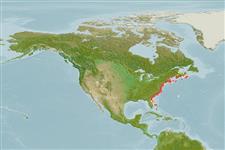Classification / Names
Common names from other countries
Main reference
Size / Weight / Age
Max length : 98.0 cm TL male/unsexed; (Ref. 40637); common length : 50.0 cm TL male/unsexed; (Ref. 3702); max. published weight: 8.9 kg (Ref. 40637)
Length at first maturity
Lm ?, range 14 - 22.5 cm
Environment
Marine; brackish; demersal; oceanodromous (Ref. 51243); depth range 10 - 26 m (Ref. 54407)
Climate / Range
Subtropical; 17°C - 27°C (Ref. 54461), preferred 13°C (Ref. 107945); 47°N - 27°N, 82°W - 59°W
Distribution
Short description
Dorsal
spines
(total): 11;
Dorsal
soft rays
(total): 25-29;
Anal
spines: 2;
Anal
soft rays: 11 - 13. Body greenish grey above and silvery below, back with small spots forming undulating dotted lines. Pelvic fins and anal fin yellowish other fins pale, sometimes with a yellowish tinge. Inside of opercle dark, visible externally. Mouth large, oblique, lower jaw projecting. Upper jaw with a pair of large canine-like teeth at tip. Chin without barbels or pores. Snout with only 1 marginal pore. Gas bladder with a pair of nearly straight, horn-like appendages. Soft portion of dorsal fin covered with small scales up to 1/2 of fin height (Ref 51721).
IUCN Red List Status (Ref. 115185)
Threat to humans
Harmless
Human uses
Fisheries: commercial; gamefish: yes; aquarium: public aquariums
Tools
Special reports
Download XML
Internet sources
Estimates of some properties based on models
Phylogenetic diversity index
PD50 = 0.5000 many relatives (e.g. carps) 0.5 - 2.0 few relatives (e.g. lungfishes)
Trophic Level
3.8 ±0.2 se; Based on diet studies.
Resilience
Medium, minimum population doubling time 1.4 - 4.4 years (K=0.26-0.3; Fec = 45,000)
Vulnerability
Moderate to high vulnerability (45 of 100)
Price category
